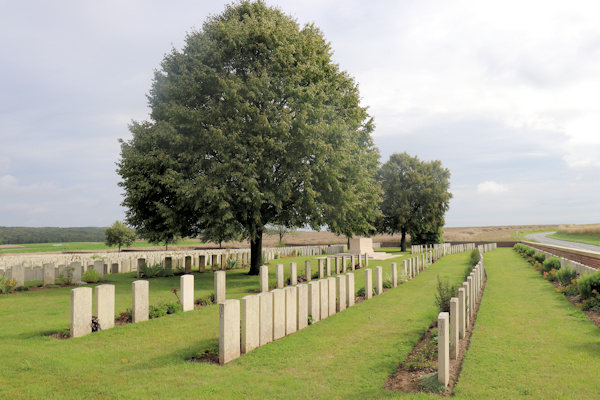Name
William Chamberlain
1889
Conflict
First World War
Date of Death / Age
01/07/1916
Rank, Service Number & Service Details
Private
21056 poss 21050
Border Regiment
2nd Bn.
Awards: Service Medals/Honour Awards
1914 (Mons) Star, British War and Victory Medals
Cemetery/Memorial: Name/Reference/Country
DANTZIG ALLEY BRITISH CEMETERY, MAMETZ
IX. I. 4.
France
Headstone Inscription
No Report
UK & Other Memorials
Wheathampstead Village Memorial, Stevenage Old Town Memorial, St Nicholas' Church Memorial, Stevenage Old Town, Holy Trinity Church Memorial Roll of Honour, Stevenage Old Town, Not on Hitchin Memorials
Pre War
William was born in 1889 in Hitchin to Sarah Chamberlain, a domestic servant. He had an older brother Archie (born 1882) and two younger sisters Annie Elizabeth (born 1891)and Edith (born 1898).
In the 1891 Census William with his mother and sister Annie Elizabeth was registered in the Hitchin Union Workhouse in Union St, Hitchin. In these records Sarah was recorded as 31, single and born in Covington, Huntingdonshire and had worked as a domestic servant.
In 1901 William was 14 and boarding in the house of Anne E Bennet in Gustard Wood, near Wheathampstead and working as an ordinary farm labourer.
By the 1911 William was in the Bedfordshire Regiment and at the Maida Barracks Part Area 8), Stanhope Lines, Aldershot.
William had enlisted for an engagement of 6 years with the Colours (and 6 years on reserve) on 25 May 1910. Originally he had opted for the Royal Horse Artillery and Royal field Artillery, but was posted as Private 9619 in the Bedfordshire Regiment with his service now 7 years plus 5 years Reserve. He was at the Depot in Bedford from 26 May to 3 Oct 1910 being posted to 1st Battalion on 4 Oct 1910 and remained with the 1st until being posted to South Africa to join 2nd Battalion on 8 Jan 1913.
Officially he was recorded as born in Hitchin and was living there when he enlisted in Welwyn.
Wartime Service
William was originally Private 9619 in the 2nd Battalion, Bedfordshire Regiment and then 21056 2nd Battalion, Border Regiment
Following the outbreak of the Great War he returned with 2nd Battalion to UK on 12 Sep 1914 and left for France on 5 Oct 1914, landing in Zeebrugge on 7 Oct 1914. The Battalion were involved in fighting to stem the German advance in the Ypres Sector. William was wounded in Chest, and feet, on 9 Nov 1915 and returned to UK on 11 Nov 1914.
During his treatment and recovery his posting was the Bedford Depot from 12 Nov 1914. On 27 Mar 1915 he posted to 3rd( Reserve) Battalion. On 9 Nov 1915 he was transferred to Border Regiment and gained the Service Number 21056.
On 2 Jan 1916 he went to France, joining 2nd Battalion Border Regiment. As part of 7 Division the Borders were engaged in the Capture of Mametz on 1 Jul 1916 (First day of the Somme Battles). It was during this fighting that William was killed.
He and another Stevenage man, Harold Holdron were to be killed in the most renowned battle of all, the first day of The Battle of the Somme, where the British army suffered some 60,000 casualties. He fell when his battalion was involved in the assault on Mametz. The attack began at 07.27am with the Battalion being given the task of capturing a series of German trenches named; Danube Trench, Apple Alley, Shrine Alley and Hidden Lane.
The troops met with heavy machine gun fire from the village of Mametz as well as from Fricourt, which was to their left. Eventually, they managed to achieve all their objectives but had suffered 343 casualties, including William Chamberlain and he is buried in the Dantzig Alley British Cemetery, Mametz, France.
Additional Information
After his death £14 15s 2d pay owing was authorised to go to his mother Sarah on 30 August 1916. Later, a war gratuity of £10 10s was authorised to be paid to her on 12 September 1919.
His pension cards record Sarah Chamberlain as his mother and as his dependant, living at 6 Bowling Green, Stevenage. She was awarded a pension of 5s a week from 6 November 1918.
Acknowledgments
Neil Cooper



